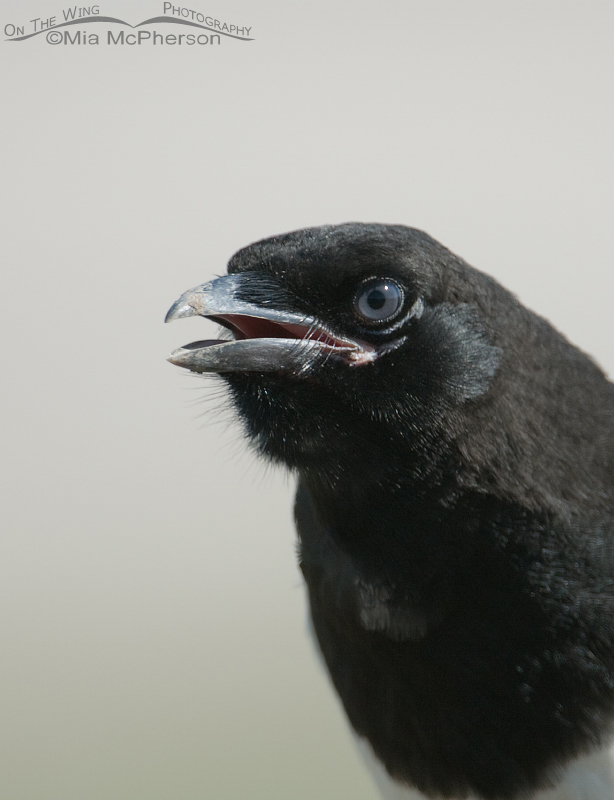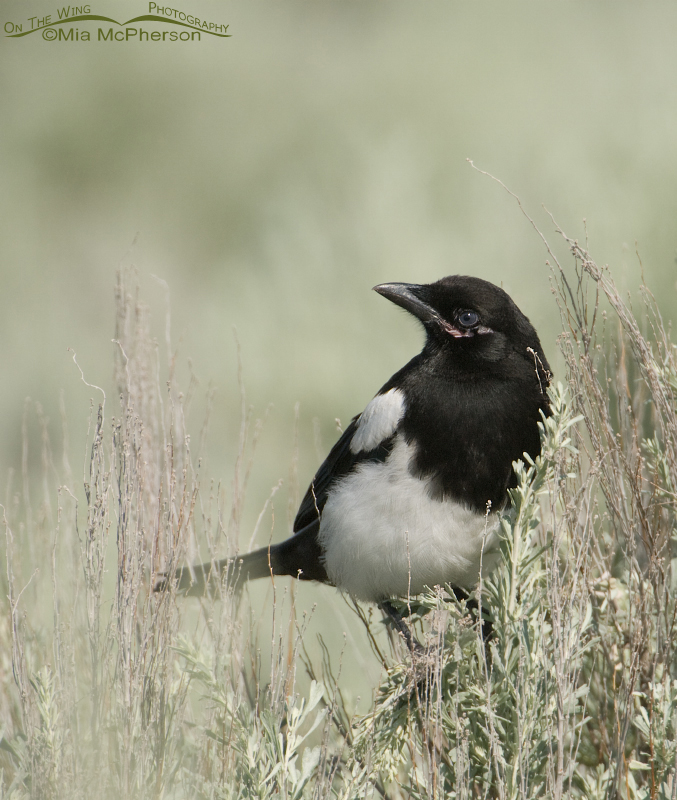Last week I happened to spot this immature Black-billed Magpie sitting on an ugly man made post. Normally I try to get full body shots but in this case I decided the perch was just too hideous and opted to take portraits of the bird instead.
 Portrait of a Black-billed Magpie juvenile- Nikon D200, f6.3, 1/500, ISO 400, +0.7 EV, Nikkor 200-400mm VR with 1.4x TC at 400mm, natural light
Portrait of a Black-billed Magpie juvenile- Nikon D200, f6.3, 1/500, ISO 400, +0.7 EV, Nikkor 200-400mm VR with 1.4x TC at 400mm, natural light
I didn’t have time to change my settings as I thought the juvenile would fly off any second so the image above does not have as much depth of field as I would have liked but I still like the great view of the eye and the open bill.
Adults have black eyes, the Black-billed Magpie juveniles have blue, gray or even violet eyes. The young magpies also have shorter tails and seem to lack the wonderful iridescence on the tail, back and wings that the adults have.
The juvenile above was calling for the adult that was nearby to come and feed it. Trust me; these young birds can make a racket! The noise this one made sure made me laugh.
 Black-billed Magpie juvenile on sage – Nikon D200, f6.3, 1/1250, ISO 400, +0.3 EV, Nikkor 200-400mm VR with 1.4x TC at 400mm, natural light
Black-billed Magpie juvenile on sage – Nikon D200, f6.3, 1/1250, ISO 400, +0.3 EV, Nikkor 200-400mm VR with 1.4x TC at 400mm, natural light
Last year I watched a Black-billed Magpie nest for weeks, as the adults built the nest and as they incubated the eggs from a respectful distance and inside a mobile blind. I missed the young birds coming out into the world for the first time and I missed it again this year. I may need to camp out there for a week to see that happen next year. But at least I have gotten some opportunities to photograph these juvenile Black-billed Magpies this spring. I am very happy about that.
By the time this is posted I will be in Montana savoring the beauty of Red Rock Lakes NWR.
Life is good.
Mia
Click here to see more of my Black-billed Magpie photos plus facts and information about this species.
Ethics on photographing nesting birds:
- Do not approach too closely
- If the birds show any sign of distress, back away
- Don’t trim leaves, twigs or branches to get a clearer shot, you may inadvertently attract predators or cause the eggs/chicks to over heat
- Follow local, state and federal guidelines concerning nesting birds
- Don’t harass the birds to get an action shot
- Don’t stay a long time with nesting birds or chicks, that disrupts their normal behavior
- Always remember that your scent may draw predators to the area of nesting birds or birds with chicks.
For more information on the ethics of photographing nesting birds or chicks please have a look at the Principles of Birding Ethics published by the American Birding Association.

